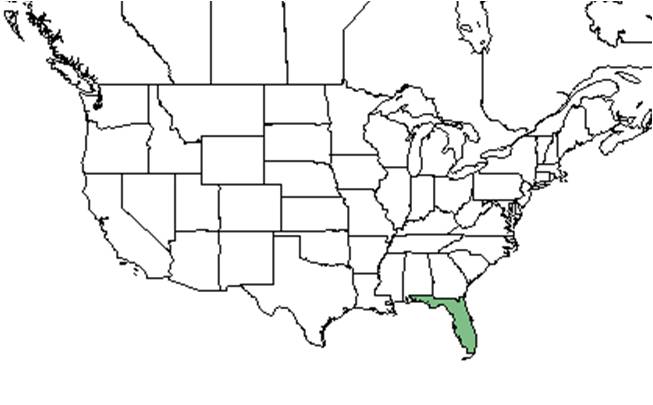Difference between revisions of "Quercus inopina"
Krobertson (talk | contribs) |
Krobertson (talk | contribs) |
||
| Line 31: | Line 31: | ||
==Ecology== | ==Ecology== | ||
===Habitat=== <!--Natural communities, human disturbed habitats, topography, hydrology, soils, light, fire regime requirements for removal of competition, etc.--> | ===Habitat=== <!--Natural communities, human disturbed habitats, topography, hydrology, soils, light, fire regime requirements for removal of competition, etc.--> | ||
| − | Habitats of ''Q. inopina'' include sand pine-evergreen scrubs, dry slash pine flatwoods, and longleaf pine/scrub oak communities in central Florida<ref name="fsu">Florida State University Robert K. Godfrey Herbarium database. URL: http://herbarium.bio.fsu.edu. Last accessed: November 2015. Collectors: Loran C. Anderson, H.S. Conard, Robert K. Godfrey, Ann F. Johnson, John G. Rae. States and Counties: Alabama: Baldwin. Florida: Highlands, Manatee, Martin, Osceola, Polk, St. Lucie. Compiled by Tall Timbers Research Station and Land Conservancy</ref> | + | Habitats of ''Q. inopina'' include sand pine-evergreen scrubs, dry slash pine flatwoods, and longleaf pine/scrub oak communities in central Florida.<ref name="fsu">Florida State University Robert K. Godfrey Herbarium database. URL: http://herbarium.bio.fsu.edu. Last accessed: November 2015. Collectors: Loran C. Anderson, H.S. Conard, Robert K. Godfrey, Ann F. Johnson, John G. Rae. States and Counties: Alabama: Baldwin. Florida: Highlands, Manatee, Martin, Osceola, Polk, St. Lucie. Compiled by Tall Timbers Research Station and Land Conservancy</ref> Associated species include ''Quercus chapmanii, Q. geminata, Q. myrtifolia, Fraxinus floridana, Ilex arenicola'', and ''Persea humilis''. It composes 30 to 40% of the cover in scrubby flatwoods.<ref name="johnson">Johnson, A. F. and W. G. Abrahamson (2002). "Stem Turnover in the Rhizomatous Scrub Oak, Quercus Inopina, from South-Central Florida." The American Midland Naturalist 147(2): 237-246.</ref> |
===Phenology=== <!--Timing off flowering, fruiting, seed dispersal, and environmental triggers. Cite PanFlora website if appropriate: http://www.gilnelson.com/PanFlora/ --> | ===Phenology=== <!--Timing off flowering, fruiting, seed dispersal, and environmental triggers. Cite PanFlora website if appropriate: http://www.gilnelson.com/PanFlora/ --> | ||
Revision as of 11:16, 18 August 2016
| Quercus inopina | |
|---|---|

| |
| Photo by Mark A. Garland, hosted by the USDA-NRCS PLANTS Database | |
| Scientific classification | |
| Kingdom: | Plantae |
| Division: | Magnoliophyta - Flowering plants |
| Class: | Magnoliopsida – Dicotyledons |
| Order: | Fagales |
| Family: | Fagaceae |
| Genus: | Quercus |
| Species: | Q. inopina |
| Binomial name | |
| Quercus inopina Ashe | |

| |
| Natural range of Quercus inopina from USDA NRCS Plants Database. | |
Common names: sandhill oak, Florida scrub oak
Contents
Taxonomic notes
Description
A description of Quercus inopina is provided in The Flora of North America.
This species is very similar to Q. myrtifolia how ever they can be distinguished in areas of sympatry by soil. Q. inopia occupies nutrient poor soil of St. Lucie type, while Q. myrtifolia occupies slightly more nutrient rich soils on yellow sands of the Paola or Lake variety.[1]
Distribution
Q. inopina is endemic to Florida, in the xeric, nutrient poor sands of ancient dunes.[2]
Ecology
Habitat
Habitats of Q. inopina include sand pine-evergreen scrubs, dry slash pine flatwoods, and longleaf pine/scrub oak communities in central Florida.[3] Associated species include Quercus chapmanii, Q. geminata, Q. myrtifolia, Fraxinus floridana, Ilex arenicola, and Persea humilis. It composes 30 to 40% of the cover in scrubby flatwoods.[1]
Phenology
It has been observed flowering in April and fruiting in August[3]. Acorns mature in two years, with the cup covering half of the nut, and the pubescent cup scales[4].
Fire ecology
Approximately 70% of the biomass of Q. inopina is belowground, consisting of a network of branching and anastomosing rhizomes which vertical stems arise in clusters. The allocation of this much biomass below ground allows this species to resprout from rhizomes after fire, within 3 years postfire, the oak may regain its pre-burn cover[1].
Pollination
The following Hymenoptera families and species were observed visiting flowers of Quercus inopina at Archbold Biological Station: [5]
Apidae: Apis mellifera, Bombus impatiens
Colletidae: Colletes brimleyi
Conservation and management
This species in endemic to central Florida along ancient dunes. Even with it's habitat degrading, the local abundance on protected land causes it to not be considered vulnerable[6].
Cultivation and restoration
Photo Gallery
References and notes
Florida State University Robert K. Godfrey Herbarium database. URL: http://herbarium.bio.fsu.edu. Last accessed: November 2015. Collectors: Loran C. Anderson, H.S. Conard, Robert K. Godfrey, Ann F. Johnson, John G. Rae. States and Counties: Alabama: Baldwin. Florida: Highlands, Manatee, Martin, Osceola, Polk, St. Lucie. Compiled by Tall Timbers Research Station and Land Conservancy.
- ↑ 1.0 1.1 1.2 Johnson, A. F. and W. G. Abrahamson (2002). "Stem Turnover in the Rhizomatous Scrub Oak, Quercus Inopina, from South-Central Florida." The American Midland Naturalist 147(2): 237-246.
- ↑ [[1]]Encyclopedia of Life. Accessed: March 7, 2016
- ↑ 3.0 3.1 Florida State University Robert K. Godfrey Herbarium database. URL: http://herbarium.bio.fsu.edu. Last accessed: November 2015. Collectors: Loran C. Anderson, H.S. Conard, Robert K. Godfrey, Ann F. Johnson, John G. Rae. States and Counties: Alabama: Baldwin. Florida: Highlands, Manatee, Martin, Osceola, Polk, St. Lucie. Compiled by Tall Timbers Research Station and Land Conservancy
- ↑ [[2]]University of Florida Extension. Accessed: March 4, 2016
- ↑ Deyrup, M.A. and N.D. 2015. Database of observations of Hymenoptera visitations to flowers of plants on Archbold Biological Station, Florida, USA.
- ↑ [[3]]Accessed: March 7, 2016